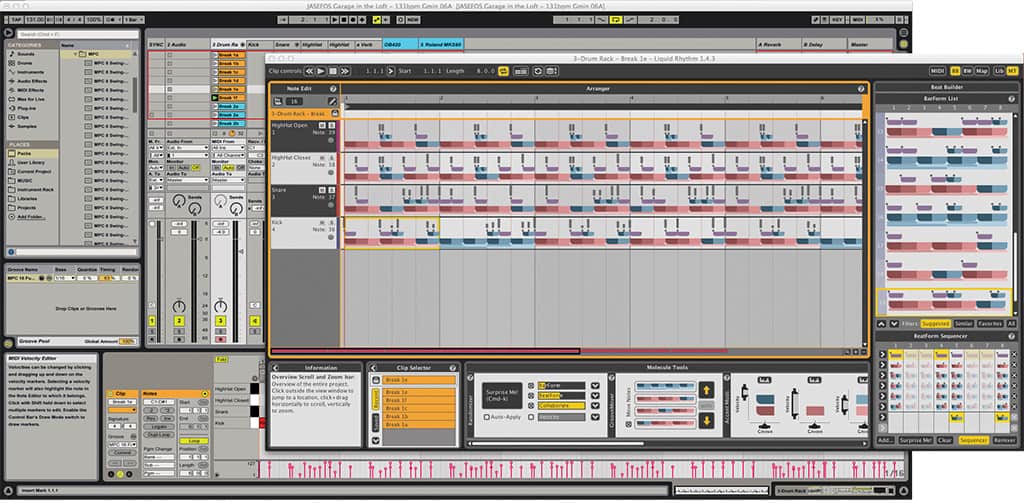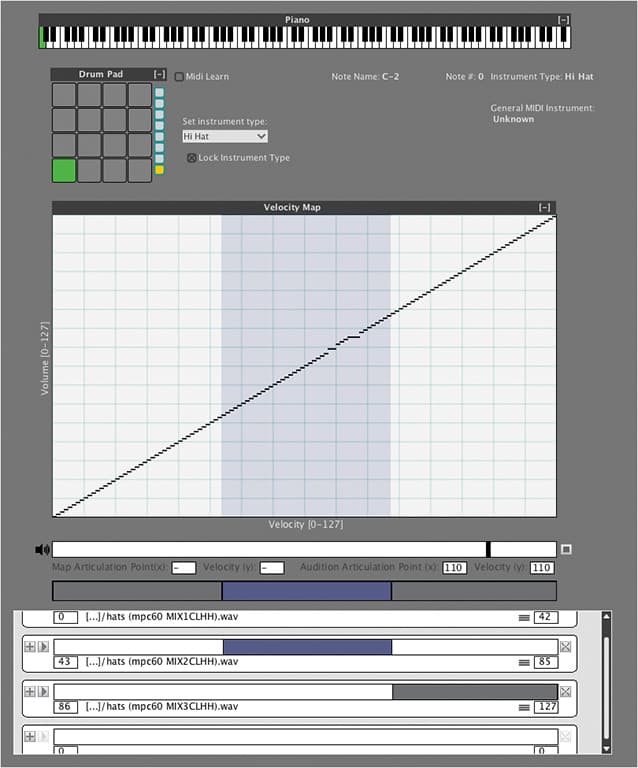
Review: WaveDNA Liquid Rhythm
Liquid Rhythm breaks beats down to the molecular level for deep-tissue manipulation.
Review: Christopher Holder
Although I’ve developed dexterous finger drumming skills over the years, beat composition tools have become a gateway to more exotic grooves I’d never play habitually. WaveDNA’s Liquid Rhythm is a rhythm sequencer that — rather than plotting in individual notes into a piano roll or sequencer — cheats for you and puts in note clusters. It’s all based around WaveDNA’s Molecule system, which presents MIDI in a whole new way.
Liquid Rhythm can be invoked as a standalone instrument or DAW plug-in (AU/VST/RTAS). Both modes include a built-in drum sample player, but when opened as a Max4Live device it only displays the sequencer, relying on the user to insert a Drum Rack after it to provide sounds — a preferable option for anyone using their own drum kits.
It’s clear the sample player is not the focus here. A mere four drum kits are preloaded (expandable to 12 via free download), built from 200+ instruments comprising velocity switched multi-samples. The Library also contains 769 loops, which may serve as an easy starting point for beginners. It’s possible to build kits from scratch using your own drum samples, however don’t expect more than a basic multi-sample player since there are no synthesis functions. Liquid Rhythm is best considered a specialised sequencer for the other drum instruments in your DAW.
BUILDING BEATS
When opened as a plug-in, Liquid Rhythm’s Library appears on the left; the Arranger, Mixing panel, and Molecule Tools down the centre; and the Beat Builder to the right.
After loading a kit from the Library, you create beats by clicking on an empty measure on the Arranger canvas and selecting a BarForm from the Beat Builder. The selected instrument type determines the initial palette of suggested BarForms. Once you’ve selected a ballpark BarForm, you can use the BeatForm Sequencer to add, subtract or replace note clusters in the current measure.
Delving further into this new mode of beat-making, you can also use the BeatWeaver and circular BarForm/BeatForm Maps to construct beats. The BeatWeaver basically lets you dial in (with a pot) the complexity of each BeatForm, while keeping the others in the measure locked in. And the Maps present palettes of 256 BeatForms/BarForms, organised by increasing complexity, that may be dragged onto the canvas.
If your beat’s still lacking magic, Molecule Tools can add randomisation and dynamic accent/groove functions via the Randomizer, GrooveMover, Accent Mods, BeatForm Palette, BeatForm Tumbler, and BeatForm Shifter. All the parameters can be MIDI mapped for mouse-free interaction.
Of course, if you want to manually sculpt your beats, you can engage Drawing or Painting mode to insert notes or BeatForms directly on the canvas. This can aid in finessing the results of randomly-spawned patterns. And a drag’n’drop style MIDI export function is provided for arranging patterns you create within DAW tracks.
NEED TO KNOW





MAX4LIVE HAT TRICK
I really started to hit my stride with Liquid Rhythm when using it as a Max4Live MIDI effect. It sits in series before a Drum Rack, which means events within the currently selected clip (including kit piece names from the Drum Rack) appear in Liquid Rhythm’s Arrangement canvas. Any changes you make in Liquid Rhythm are dynamically updated in the Live clip. Better still, you can apply Live’s Groove Templates to clips and hear the results in real-time.
Used in this manner you could consider it to be a rhythm-dedicated ‘inspector’ for Live’s MIDI Clips allowing you to add subtle fills and variations to an existing drum track. It may also be configured for use with non-Drum Rack-based clips — i.e. other drum synths or melodic parts can join the party.
PUSH TO DEVICE
Liquid Rhythm can be deeply integrated with a selection of control surfaces including Ableton’s Push, Livid Instrument’s Base II and Smithson Martin’s Emulator Elite touch surface. With these controllers you gain hands-on control of the BeatForm step sequencer, arrangement, humanisation and groove functions that could spice up live performances.
For those indulging in rhythmically complicated genres such as Dubstep, Drum’n’Bass, Future Bass and Glitch Hop, this instrument provides fertile ground for cultivating intricate beats with little effort, while maintaining the hallmarks of your preferred sound design workflow. My only criticism would be that it requires workarounds to operate in time signatures outside of 4/4. Although it takes some time to master its voodoo, Liquid Rhythm may hold the key to busting a beat maker’s block!
















RESPONSES